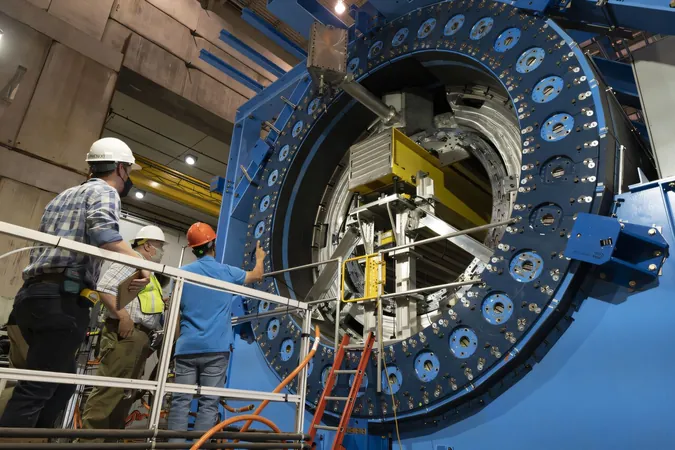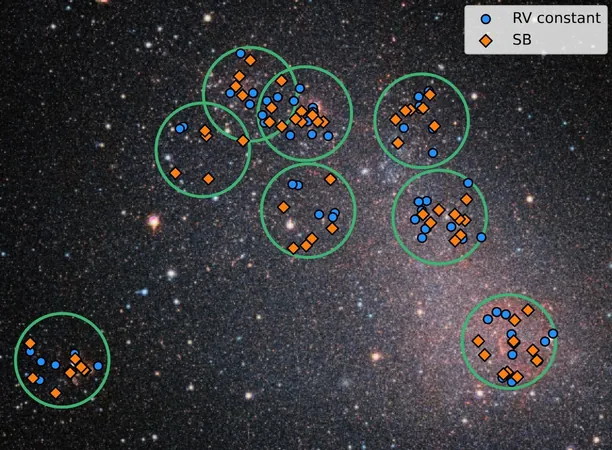
Revolutionary Particle Detector Set to Unlock Secrets of the Universe
2025-09-03
Author: Sarah
A New Era in Particle Physics
A groundbreaking particle detector, the sPHENIX, has recently demonstrated its extraordinary precision in an essential test that could unravel the mysteries of the cosmos. Located at Brookhaven National Laboratory's Relativistic Heavy Ion Collider (RHIC), this cutting-edge detector is engineered to meticulously analyze high-speed particle collisions.
Decoding the Quark-Gluon Plasma
Scientists are aiming to use the sPHENIX detector to probe the elusive quark-gluon plasma (QGP)—a searing hot mixture of quarks and gluons believed to have formed just microseconds after the Big Bang. This plasma quickly cooled, evolving into the protons and neutrons that constitute ordinary matter today.
Key Milestone Achieved
In a groundbreaking study published in the Journal of High Energy Physics, researchers from various institutions, including MIT, confirmed that sPHENIX can accurately measure both the quantity and energy of particles erupting from collisions of gold ions traveling at nearly light speed.
Testing the Limits of Precision
This milestone test is vital in the realm of particle physics, serving as a 'standard candle'—a benchmark for measuring a detector's accuracy. The findings illustrate that head-on collisions generated ten times the charged particles and energy compared to more oblique collisions, validating the detector's capabilities.
"It's akin to launching a new telescope and capturing our first image—proof that it's ready for groundbreaking discoveries," said Gunther Roland, a professor of physics at MIT.
Venturing into the Dawn of Time
The sPHENIX team, comprising over 300 scientists globally, is enthusiastic about how this advanced technology will advance our understanding of QGP's development and characteristics, crucial for reconstructing early universe conditions. Hao-Ren Jheng, a lead co-author, expressed optimism about the insights that sPHENIX will bring.
The Nature of Quark-Gluon Plasma
Within giant particle colliders like RHIC, particles accelerate to relativistic speeds, occasionally colliding with explosive results that engender ultra-brief bursts of QGP. This state exists for a staggering 10^-22 seconds, reaching temperatures of several trillion degrees Celsius, acting as a 'perfect fluid' before instantly transitioning to ordinary matter.
Pioneering Technology at Work
The sPHENIX detector is the latest iteration building on Brookhaven's original PHENIX experiment. Installed in 2021, this immense apparatus—akin to a two-story house—captures an astonishing 15,000 particle collisions every second, thanks to its innovative design, including contributions from MIT's Bates Research and Engineering Center.
As the detector undergoes rigorous testing, scientists are keenly analyzing its performance, having recently completed a significant 'standard candle' evaluation that confirmed its operational success.
Looking Ahead to New Discoveries
The excitement surrounding sPHENIX is palpable. As researchers continue to run experiments, they anticipate uncovering rare phenomena that could illuminate aspects of QGP density, particle behavior in extreme conditions, and the fundamental forces binding particles together. "The fun for sPHENIX is just beginning," said postdoc Cameron Dean, highlighting the potential for transformative findings ahead.





 Brasil (PT)
Brasil (PT)
 Canada (EN)
Canada (EN)
 Chile (ES)
Chile (ES)
 Česko (CS)
Česko (CS)
 대한민국 (KO)
대한민국 (KO)
 España (ES)
España (ES)
 France (FR)
France (FR)
 Hong Kong (EN)
Hong Kong (EN)
 Italia (IT)
Italia (IT)
 日本 (JA)
日本 (JA)
 Magyarország (HU)
Magyarország (HU)
 Norge (NO)
Norge (NO)
 Polska (PL)
Polska (PL)
 Schweiz (DE)
Schweiz (DE)
 Singapore (EN)
Singapore (EN)
 Sverige (SV)
Sverige (SV)
 Suomi (FI)
Suomi (FI)
 Türkiye (TR)
Türkiye (TR)
 الإمارات العربية المتحدة (AR)
الإمارات العربية المتحدة (AR)